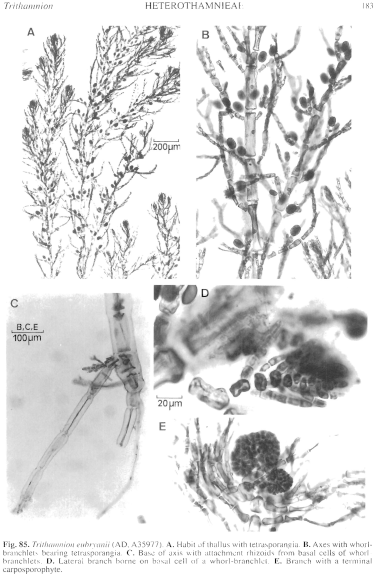|
|
|
|
|
|||||||||||
|
Electronic Flora of South Australia Species Fact Sheet
Phylum Rhodophyta – Order Ceramiales – Family Ceramiaceae – Tribe Heterothamnieae
Thallus (Fig. 85A) red-brown, 5–12 mm high, with slight prostrate parts bearing erect branches, each axial cell with (2–) 3 whorl-branchlets (Fig. 85B), one distinctly larger than the other 2 and often developing into a longer lateral branch. Attachment by slender rhizoids (Fig. 85C) produced from the basal cells of whorl-branchlets; on solid substrates (jetty piles and rope). Structure. Apices relatively straight, overtopped by whorl-branchlets from below, with several small cells then enlarging gradually. Apical cells 5–8 µm in diameter and L/D 1.5–2, enlarging to mid axial cells 20–30 µm in diameter and L/D 3–4 (–5), then to 70–120 µm in diameter and L/D 2–4 in the lower erect thallus and prostrate axes. Whorl-branchlets slender, with usually 2 shorter ones 130–180 µm long, simple or usually with 1 or 2 short branches, and 1 longer branchlet 200–450 µm long with several branches; the latter often extends further as a lateral branch; basal cells unbranched, 11–18 µm in diameter and L/D 1.5–2, of similar size to next cells, tapering gradually to single or twinned apical cells 6–10 µm in diameter and L/D 1.2–1.8, with rounded ends; gland cells (Fig. 85D) usually touching only the bearing cell and shorter than it, cut off from terminal and subterminal whorl-branchlet cells, ovoid when mature, 8–16 µm in diameter. Lateral branches arising on the basal cells of whorl-branchlets (Fig. 85D). Cells usually binucleate (1–3); rhodoplasts discoid in small cells, becoming ribbon like in axial cells.
Reproduction: Carpogonial branches borne on 2-celled whorl-branchlets close to axial apices; post-fertilization, partial fusions of procarpic cells occur and a terminal then lateral rounded gonimolobes 150–200 µm across develop with ovoid carposporangia 10–15 µm in diameter. The carposporophyte (Fig. 85E) is terminal on lateral branches, surrounded by usually 4 lateral branches from the lower 1 (or 2) cells. Spermatangia unknown.
Tetrasporangia (Fig. 85A, B) occur adaxially on the basal and next cell of whorl-branchlets, sessile, ovoid, 30–35 µm in diameter, tetrahedrally, subdecussately or cruciately divided.
Type from Port Noarlunga, S. Aust., on rock near jetty, 5 m deep (Hergstrom & Owen, 19.vii.1970); collection in AD, A35977, holotype in GB.
Selected specimens: Kingscote, Kangaroo I., S. Aust., on jetty piles, 1–2 m deep (Lutz, 29.xi.1968; AD, A33036). Warrnambool, Vic., on Heterozostera, drift (Womersley, 14.x.1985; AD, A5687I). Apollo Bay, Vic., on rope, just submerged (Engler, 19.v.1980; AD, A51077).
Distribution: Port Noarlunga and Kingscote, Kangaroo I., S. Aust. to Point Lonsdale, Vic. (Athanasiadis 1966, p. 99).
Taxonomic notes: T. eubryanii appears to occur in relatively sheltered waters, but further study is needed of a larger range of specimens.
References:
ATHANASIADIS, A. (1996). Morphology and classification of the Ceramioideae (Rhodophyta) based on phylogenetic principles. Opera Botanica No. 128, pp. 1–216.
The Marine Benthic Flora of Southern Australia Part IIIC complete list of references.
Publication:
Womersley, H.B.S. (24 December, 1998)
The Marine Benthic Flora of Southern Australia
Rhodophyta. Part IIIC. Ceramiales – Ceramiaceae, Dasyaceae
©State Herbarium of South Australia, Government of South Australia
Illustration in Womersley Part IIIA, 1998: FIG. 85.

Figure 85 enlarge
Fig. 85. Trithamnion eubryanii (AD, A35977). A. Habit of thallus with tetrasporangia. B. Axes with whorl-branchlets bearing tetrasporangia. C. Base of axis with attachment rhizoids from basal cells of whorl-branchlets. D. Lateral branch borne on basal cell of a whorl-branchlet. E. Branch with a terminal carposporophyte.

|
Email Contact: State Herbarium of South Australia |

|